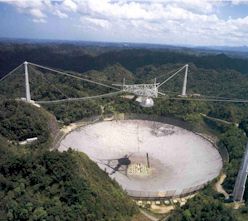Beginnings of radio astronomy
In 1925, just a dozen years after engineers learned to generate radio waves using an electron tube, Gregory Breit and Merle Tuve, working for the Carnegie Institution of Washington DC, bounced radio waves off the ionosphere and thus determined its height. This showed that radio waves could be used as a probe. Two years later the well-known radio enthusiast and popularizer Hugo Gernsback proposed, in an article in Radio News entitled "Can we radio the planets?", that radio waves be bounced off the moon and planets, and he calculated 2.5 seconds as the time for a signal to travel to the moon and back.
In the early 1930s at Bell Telephone Laboratories, Karl Guthe Jansky was investigating the noise in the radiotelephone transmissions across the Atlantic Ocean. He distinguished three types of static: crashes from local thunderstorms, a steadier and weaker static from the combined effect of distant storms, and a weak hiss of unknown origin.
In an article in 1933 Proceedings of the IRE, he first reported these results, suggesting that the weak hiss might be associated with the sun. He investigated the noise further with a highly directional antenna at the 14.6m wavelength. He found that the antenna noise attained at maximum was time shifted by 4 minutes per day - the difference between stellar time and solar time. He identified the position of maximum intensity with a position at the center of our Galaxy. He had discovered what we now know to be the diffuse galactic synchroton emission.
One might imagine that such results, widely reported as they were, would initiate a new branch of astronomy. But Bell Labs rejected Jansky's request to build a 100-foot antenna, and he was given other assignments. No academic institutions followed up on Jansky's work. And until after World War II apparently the only person who did was Grote Reber, a radio engineer in Wheaton, Illinois, who pursued it as a hobby in his spare time. Reber built a 31-foot parabolic antenna and in 1937 made the first radio maps of the sky.
The intense development of radar during the war greatly advanced the sort of techniques needed for radio astronomy. In 1945 Arthur C. Clarke published an article on "The astronomer's new weapons—electronic aids to astronomy". He discussed the possibility of using radar to probe the planets. An obvious first step was radar detection of the moon, and in early 1946 two groups succeeded: a U.S. Army Signal Corps team headed by J.H. De Witt saw echoes of the moon on an cathode ray tube, and Z. Bay in Hungary, in an ingenious but less direct manner, obtained evidence of echoes of the moon.
In the late 1940s and early 1950s radio astronomy finally emerged as a new branch of astronomy. Taking the lead were groups from Manchester University, Cambridge University, and the Australian Commonwealth Scientific and Industrial Research Organisation (CSIRO). Though radar continued to be developed for investigating meteors and planets, the principal mode of investigation was the mapping of distant radio sources. A 76-meter steerable radio-telescope was completed at Jodrell Bank, England, in 1957, Parkes, Australia completed in 1961 and a 305-meter fixed reflector was completed in Arecibo, Puerto Rico, in 1963.
Further Reading
Parkes and 21cm History - This article is around the Parkes, Australia observatory, and includes other historical information.
